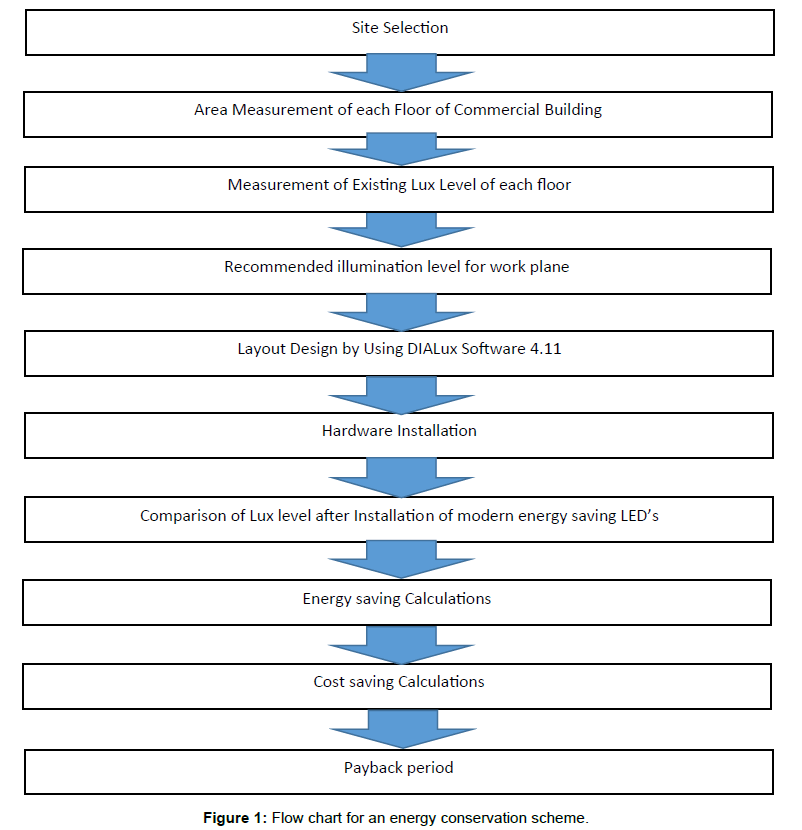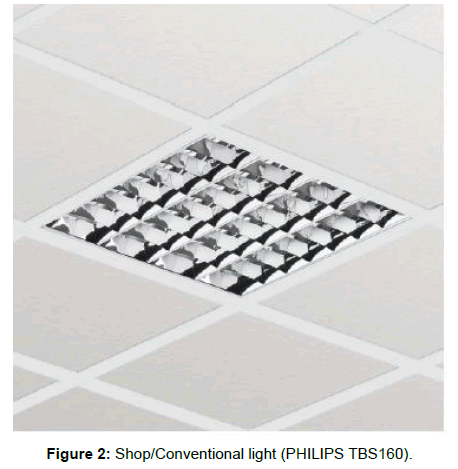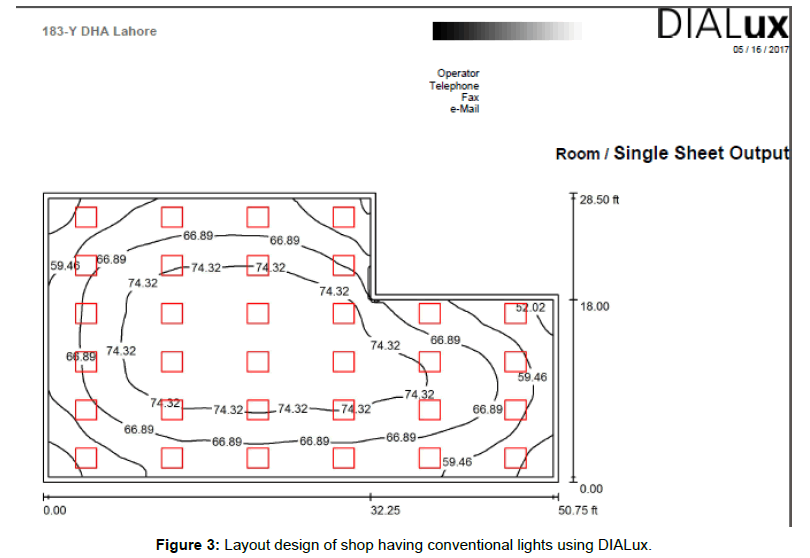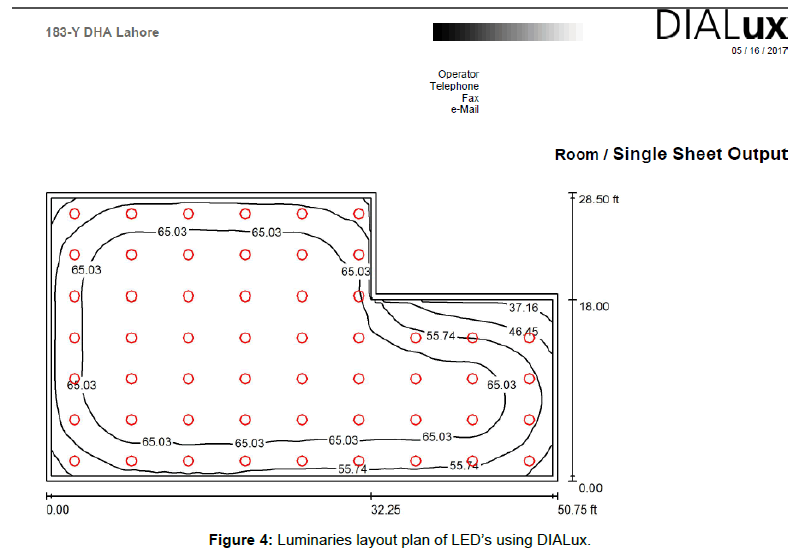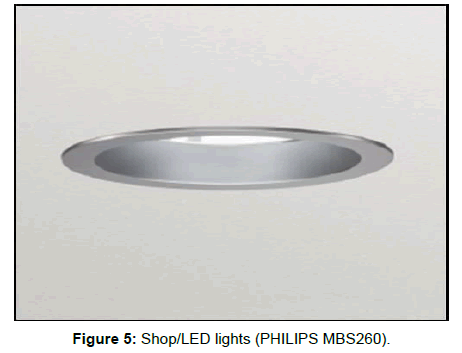Research Study on Gained Energy Efficiency in a Commercial Setup by Replacing Conventional Lights with Modern Energy Saving Lights
Received: 25-May-2017 / Accepted Date: 05-Jun-2017 / Published Date: 11-Jun-2017 DOI: 10.4172/2168-9717.1000202
Abstract
Lighting accounts for roughly one-fifth of global electricity consumption. The energy consumption for buildings lighting system can reach 30% of the total consumption. The demand for energy is growing day by day with growth in population, revolution in life style, and change in technology. This growing demand led to energy crisis which is the biggest warning for economic stability for developing countries like Pakistan. From the last ten years, Pakistan is facing severe electrical energy shortfall and thus the problem of balancing Pakistan's power supply and the demand has remained in a stalemate position. This crisis has badly affected the everyday life, business and industry. Despite taking steps like resolving this issue through initiating a number of power plant projects, the country still faces a significant energy shortfall. Hence, in order to reduce the gap between electricity demand and supply, the need for efficient usage of available electric energy through opting for the modern, highly energy efficient devices/systems cannot be undermined. A possible way to reduce the electricity consumption, and thus the energy bill, is related to the substitution of the old lamps and control of the new ones. Significant energy conservations can be achieved by reducing energy depletion by artificial lighting which has potential of energy saving by using efficient lighting technologies. For this purpose, new performance lamps like LEDs are studied and developed. Light Emitting Diodes (LEDs) have recently entered the lighting market as an energy efficient alternative to traditional light sources such as incandescent and fluorescent bulbs. A case study is carried out for a commercial setup to compare the enactment, suitability, sustainability and economic effects of conventional and LED lights in a commercial setup. An innovative lighting scheme has been designed by using DIALux simulation software based on international standards of Illuminating Engineering Society of North America (IESNA).The conventional lights on the shop floor has been substituted with LED lights as per software design. After hardware installation, it is revealed that by implementing this lighting scheme there is 47% of energy savings and user satisfaction with financial savings of Rs. 55570 per year, having 1.368 years payback period that validates use of LEDs as per proposed lightning design for wide-ranging lighting solicitations
Keywords: Light emitting diode (LED); Color rendering index (CRI); Compact fluorescent light (CFL)
77278Introduction
Lighting usage is a high part of the overall electricity consumption at worldwide. This is due to the use of a long time and it is an essential element of any building. Normally, commercial buildings using light from 50% of total electricity consumption in a country. Pakistan electricity sector is a developing market. For years, the matter of balancing the country's supply against the demand for electricity had remained a largely unresolved matter. The country faced significant challenges in revamping its network responsible for the supply of electricity. Other problems included lack of efficiency, rising demands for energy, and political instability [1]. At one point electricity generation had shrunk by up to 50% due to an over-reliance on fossil fuels [2]. The country was hit by its worst power crisis in 2007 when production fell by 6000 Megawatts and massive blackouts followed suit [3]. Load Shedding and power blackouts had become severe in Pakistan before 2016 [4].
It is a fact that if the Pakistan has to meet the industrial, commercial as well as home needs then they have to pay their 80% of the attention in conservation of energy in buildings by smart technologies. Because, as the years have been passing, the want for the electricity in Pakistan is increasing [5]. 20-50% of global energy is consumed by buildings as artificial lighting [6]. In industries 4-5% of total industrial electrical energy is consumed for lighting [7].
In the last years, the lighting systems concept has evolved. The lighting system should no longer ensure only operational performances and economy, but also should provide customers visual comfort (pleasant environments, color rendition, color temperature, etc.). The prospect of improving lighting technology may include energy efficiency, light depreciation, lifetime, light output and distribution, extremely small sizes and consequently extreme flexibility of use, color quality, color shift, and dimmability. Recent advancement in lightemitting diode (LED) technology has made the widespread commercial use of LED lighting a very realistic possibility for the near future. New LED lights offer many advantages when compared to fluorescent or incandescent lights. First, the latest LED bulbs last up to five times longer than traditional fluorescent bulbs, and nearly 50 times longer than incandescent bulbs. Additionally, new LED light bulbs use half the electricity than compact fluorescent bulbs use in the same allotted time, and less than a quarter of the electricity used by incandescent bulbs. The major drawback to buying the most current LED light bulbs is the price. However, users of LED light bulbs can recover this high overhead cost in energy savings over time, saving money in the long run [8,9].
LEDs have reached interesting features such as:
• High luminous efficiency (90-100 lm/W);
• lower losses in the distribution of the controlled luminous flux compared to traditional lamps (emitting only a beam of 120°, while traditional have about 360°);
• Extremely small sizes and consequently extreme flexibility of use;
• Good color rendition (Color Rendering Index, CRI≥80);
• Wide range of color temperature;
• light-up instantaneously;
• Fully dimmable without color variation;
• Colored light without filters;
• Dynamic color control.
These new lamps, compared to traditional ones, have very high costs. The advantages of this technology are exploited in applications where the particular characteristics of the LEDs (small size, light colored or dynamic) are used [10-12].
Therefore, traditional light sources are replaced with LED’s for energy saving, financial effects, better performance, high for bearance to dampness, cool operation, extended life and are highly efficient as shown in Table 1. The paper illustrates, based on a practice application, how the LED use makes possible a substantial energy saving. In addition, the use of LEDs makes possible the architectural redevelopment of specific environments and the redesign of historical luminaries, currently characterized by traditional lamps.
| Light Type | Output (Lumen/Watt) | Estimated Life Span (Years) | Maintenance cycles |
|---|---|---|---|
| LED | 20-120 | 34 | Nil |
| HPS | 80-100 | 2 | 17 |
| CFL | 50-100 | 1 | 34 |
| Incandescent | 20 | 6 months | 68 |
Table 1: Comparison of LED and its types with Traditional light source [12].
Earlier it was common with light levels in the range 100 - 300 lux for normal activities. Today the light level is more common in the range 500-1000 lux - depending on activity (Table 2) [13].
| Activity | Illumination (lux, lumen/m2) |
|---|---|
| Offices and shops | |
| Computer rooms | 500 |
| Drawing offices drawing boards | 750 |
| Reference table and general | 500 |
| Shops | |
| Conventional with counters | 500 |
| Conventional with wall display | 500 |
| General | 500 |
Table 2: Recommended light levels for different work spaces [13].
Color Rendering Index (CRI) would measure the ability of a light source to accurately render all frequencies of its color spectrum when compared to a perfect reference light of a similar type. The lower the CRI rating, the less accurately colors will be reproduced. That’s why lights are chosen having color rendering index greater than 80 to render all colors accurately (Table 3) [14].
| Source | CRI |
|---|---|
| Tungsten Halogen bulb | 100 |
| Fluorescent Bulb | 90 |
| HMI | 95+ |
| LED | 70-90+ |
Table 3: Comparison of CRI of different light sources [14].
LEDs are widely used for high output light bulbs, 12 volt DC light bulbs, lighting strips, under cabinet lights, light bars, reading lamps, office lamps, floodlights, security lights, lanterns, emergency lights, head lamps, book lights, solar energy lights, outside lights, motion detecting lights , automobile industry and in many more applications [15].
Section 1 of the paper explains the different lighting technologies and their comparison with LED lights. Section-2, describes the methodology of the research adopted for replacement of conventional lights by LEDs for a commercial setup as per proposed lighting design to achieve energy and cost saving. In section-3, a case study is presented for a commercial setup through installation of hardware as per developed lighting design. Results are discussed in section-4 of paper and paper is concluded in section 5.
Methodology of Research
Figure 1 in section 3 shows the flow chart of energy conservation solution strategy In proposed methodology first of all site for the project is selected and its indoor area is measured. By using Lux meter the existing illumination level of conventional bulbs is measured. Obtained illumination level is matched with international standards of Illuminating Engineering Society of North America (IESNA). For the area/site under consideration a new lighting scheme is developed by using measurements of selected area and adding the standards for that specific environment to simulation software DIALux. As per design, the hardware is installed and illumination level is measured for LED lights by using Lux meter and results are compared with that of conventional lights prior to installation of LED lights. In order to evaluate the feasibility of Light-Emitting Diode technology as an efficient and cost effective alternative to traditional technologies for commercial lighting, we conducted extensive research, in the form of a literature review, market analysis, and cost-benefit analysis.
A comprehensive literature review of material relating to LED lighting technology was a vital element of this project. This involved a research focus on the development of the commercial lighting market, including traditional technologies and the emergence of new innovations in LED technology. In market analysis, our team was able to use data and market trends to project the near future of LED lighting and the level of opportunity available for a business entering this market. Our project’s focus was on the commercial lighting market, rather than residential or industrial lighting. A cost-benefit analysis is a business process used to evaluate the benefits of a project or decision against its’ financial costs. Our cost benefit analysis involved a comparison of LED lighting with traditional forms of commercial lighting in terms of financial costs, energy usage, product lifetime, and product performance. Finally, payback period has been calculated to justify the execution of new lighting system.
Case Study
The case study is of a commercial plaza which has ground floor, first floor and second floor. This commercial plaza is operated 12 hours in all floors. The area of each floor is similar i.e 30 ft × 60 ft including 8 ft front lobby/veranda. The ceiling height of all floors is 12 ft. The height of working plane in all floors is 0.5 ft. Electrical supply is provided by overhead bus bars. Total electrical connected load of all floors is 8.9 MW including 12 KW lighting load. Each floor was installed with 32 (PHILIPS TBS160) conventional lights suspended on roof. The illumination level on different test points with conventional lights (Philips Tube lights) is measured by Lux meter and recorded as Figures 1 and 2.
Height of Room: 12.000 ft, Mounting Height: 12.262 ft, Light loss factor: 0.67 Values in Footcandles, Scale 1:112. Figure 3 shows reduced illumination level of conventional lights. This conventional light has been simulated to evaluate effect of illuminance with artificial light. The recommended illumination level for this working environment is 47 foot candles (500 lux) as per Illumination Engineering society of North America (IESNA) [16,17]. To achieve the target illumination level, DIALux simulation software is used to design a new lighting scheme for the commercial plaza which shows number of lamps required along with layout design on luminaries. Number of lamps can also be calculated manually by using Lumen Method. The equation is appended below:
N=E × A/F × UF × MF
Where, N: Numbers of lamps required; E: Average illumination required in Lux; A: Area of working plane (m2); F: Light output from Lamp (Lumens); UF: Utilization factor (Light distribution from Lamp); MF: Maintenance factor (Reduction in light output because of deterioration and dirt.).
Figure 4 shows the layout design for a floor of the commercial plaza under consideration and showing Lux level on different points in foot candles. The designed layout consists of 54 LED lights each of 22 watts. The design shows uniform lighting scheme and Figure 4 also shows the comprehensive luminary layout for the installation of lights and distance between them horizontally and vertically along with details of work plane. Height of Room: 12.000 ft, Mounting Height: 12 ft, Light loss factor: 0.67 Values in Footcandles, Scale 1:112 (Figure 5).
Hardware installation
The lighting load of the commercial plaza was 2.240 KW which has been replaced with 1.188 KW new lighting load LED lights. The lights has been installed at the height of 12 ft from ground and the illumination level is recorded by Lux meter in foot candle on work plane (0.5 ft) on test points. The result shows that the lighting level in shop in commercial building has very much improved after installation of LED lights (Table 4).
| Types of Lights | Quantity | Total Watts | Total KW | Installation Cost (PKR) | Units Consumed/Day | |
|---|---|---|---|---|---|---|
| Conventional lights (PHILIPS TBS160 | Tube lights | 32 (70w/Each) | 2240 | 2.240 | 112,000 | 2.240 × 12=26.88 kWh |
| Energy saving light (PHILIPS MBS260) | LED’s | 54 (22w/Each) | 1188 | 1.188 | 189,000 | 1.188 × 12 =14.256 kWh |
Table 4: Conventional lights vs. LED’s.
Results and Discussions
The energy analysis of efficient lighting system design for commercial building has been successfully performed in this research work. By using DIAlux simulation, effective and accurate lighting design could be achieved. The use of color on the walls, ceiling and floor also plays an important role in energy saving. Bright colors give the percentage reflection of light higher when compared to the dark color’s. The distance between the CFL and LED can be determined automatically or manually, it depends on the designer and how to illuminate a room with average light required. Moreover, from the simulation, we can also choose the lights that are different brands and types to suit the requirements of occupants. Although the investment cost for the LED is higher than the CFL but for a longer period of usage, LED is more economical. In terms of lifespan, LED has technical life expectancy four times longer than the CFL. Before installation of LED lights the commercial building was installed with 32 traditional lights per floor with lighting load of 2.240 KW. To achieve the recommended illumination level (500 lux=47 fc) and energy savings through an efficient lighting design and use of LEDs; these conventional lights were replaced with LED lights with lighting load of 1.188 KW. The wattage of luminaries and installation cost incurred on traditional and LED bulbs is shown in Table 4. And as all floors are similar therefore calculations and results for only one floor is done. Rest of floors also have same results.
Percentage energy savings
2.240 KW lighting load of conventional lights has been replaced by 1.188 KW lighting load of LED lights saving 47% of electrical energy.
Financial effects
Detail of financial effects is given with payback period calculations.
Case (i): Light Usage Profile (Full Load).
The workshop is being operated 12 hrs per day and rate of electricity per unit is taken as PKR 12.06.
Annual Cost of Electricity Consumed by conventional Lights=26.88 × 12.06 × 365=1,18,323 PKR.
Annual Cost of Electricity Consumed by LED Lights=14.256 × 12.06 × 365=62,753 PKR.
X=Annual Cost Saving/Year=55,570 PKR.
Initial Investment on Conventional Lights=1,12,000 PKR on LED Lights=1,89,000 PKR.
Y=Difference of Installation Cost=77,000 PKR.
Simple Pay Back Period (SPBP); SPBP=Y/X=1.386 Years.
Conclusion
1. LEDs are the future technology highly promoted for their low energy consumption, long life, efficiency, reliability, and ease of use in improved and innovative designs and having potential to save energy. Case study for a commercial set up using LEDs is carried out that shows 47% of energy saving and financial savings of 555,70 PKR per year with payback period of 1.368 years. The electrical energy thus saved can contribute to various other requirements of industrial/ residential or other consumers. The results show that LEDs are best recommended for general lighting application and white LEDs are replacing incandescent and compact fluorescent lamps. The major disadvantage associated with LED lights is that the installation cost of these devices is still at higher side, however this issue can be resolved by more energy saving and reducing payback period.
2. LED lighting products are still relatively new products, and they have strong potential for continued technological advancement and innovation moving forward. LED lighting technology has been improving rapidly in recent years. Significant advancements in the energy efficiency, light quality, and lifespan of LED bulbs are expected to continue to occur for many years to come. Along with these advancements, the production costs, and therefore the retail prices, of LED lighting will inevitably decrease over time, as they have since these products were first introduced. LED lighting currently possesses only a small share of the commercial lighting market, this technology is becoming increasingly popular and a prosperous growth phase is inevitable for LED lighting in the commercial lighting market.
3. LED lighting offers a plethora of benefits compared to traditional (Incandescent, CFL) and is highly feasible for widespread use in the commercial sector. LED light bulbs offer substantial advantages over their incandescent and compact-fluorescent counterparts. Despite the fact that the initial cost of LED bulbs is significantly higher than that of traditional types of lighting, the LED bulbs offers substantial energy savings and much longer lifespans. These savings allow the initial cost of LED lighting to be recovered fairly quickly, offering consumers a positive return on their investment. Our team concluded that, from the results of our theoretical and practical cost-benefit analyses, LED lighting is absolutely a viable option to replace traditional incandescent and CFL lighting in the commercial sector.
Recommendations
1. Our team recommends that any business in the LED lighting market should educate its customers on all of the advantages LED products possess over competing products, not solely their potential energy savings.
2. Our team recommends that any business attempting to penetrate the LED lighting market ensures their product is not only innovative but offered at a competitive price.
3. Our team recommends that commercial businesses strongly consider switching from traditional lighting to LED lights.
References
- Hawken P, Lovins A, Hunter LL (2000) Natural Capitalism. Back Bay Press, Time Warner Book Group.
- Dhingra A, Singh T (2009) Various concerns regarding monitoring& measurement of power quality problems. Int J of Energy p: 3.
- Illuminating Engineering Society of North America (IESNA) (2000) Lighting Handbook.
- Industrial lighting ANSI/IESNA RP-7- 01 (1991) Recommended Practice for Industrial Facilities.
Citation: Muneeb A, Ijaz S, Khalid S, Mughal A (2017) Research Study on Gained Energy Efficiency in a Commercial Setup by Replacing Conventional Lights with Modern Energy Saving Lights. J Archit Eng Tech 6: 202. DOI: 10.4172/2168-9717.1000202
Copyright: © 2017 Muneeb A, et al. This is an open-access article distributed under the terms of the Creative Commons Attribution License, which permits unrestricted use, distribution, and reproduction in any medium, provided the original author and source are credited.
Select your language of interest to view the total content in your interested language
Share This Article
Recommended Journals
Open Access Journals
Article Tools
Article Usage
- Total views: 10566
- [From(publication date): 0-2017 - Jul 04, 2025]
- Breakdown by view type
- HTML page views: 9367
- PDF downloads: 1199

